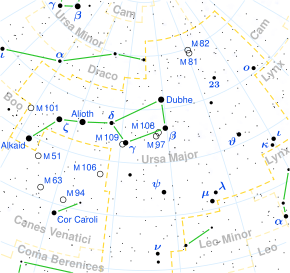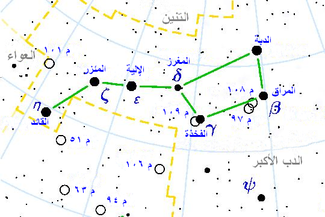الإلية (نجم)
| بيانات الرصـد الحقبة J2000 اعتدال J2000 | |
|---|---|
| الكوكبة | الدب الأكبر |
| الصعود المستقيم | 12س 54د 01.74959ث[1] |
| الميل | +55° 57′ 35.3627″[1] |
| القدر الظاهري (V) | 1.77[2] |
| الخـصـائص | |
| النوع الطيفي | A1III-IVp kB9 |
| U-B دليل الألوان | +0.02[2] |
| B-V دليل الألوان | -0.02[2] |
| النوع المتغير | α2-CVn |
| علم القياسات الفلكية | |
| السرعة القطرية (Rv) | -9.3[3] كم/ث |
| الحركة الحقيقية (μ) | RA: +111.91[1] mas/yr Dec.: -8.24[1] mas/س |
| اختلاف المنظر (π) | 39.51 ± 0.20[1] mas |
| المسافة | س ض ( ف ن) |
| القدر المطلق (MV) | –0.2[4] |
| التـفـاصـيل | |
| الكتلة | 2.91[5] M☉ |
| نصف القطر | 4.2 ± 0.2[6] R☉ |
| الضياء | 108 L☉ |
| جاذبية السطح (ج) | 3.5[4] س.ج.ث. |
| درجة الحرارة | 10,800[4] ك |
| المعدنية [Fe/H] | +0.00[4] العشرية |
| تسارع الدوران (v sin i) | 33[7] كم/ث |
| تسميات أخرى | |
| مراجع قواعد البيانات | |
| SIMBAD | data |
الإلية أو "إبسلون الدب الأكبر" ألمع نجوم كوكبة الدب الأكبر على الإطلاق والنجم الثاني والثلاثين من حيث اللمعان في السماء كلها، وذلك بقدر ظاهري يبلغ 1,76. هو آخر نجوم الذيل (يد المغرفة) من اليسار. لقد كان يُستخدم في الماضي كثيراً في الملاحة اولاستدلال على الاتجاهات. يبعد عنا 81 سنة ضوئية وتبلغ كتلته 3 كتل شمسية. ويبلغ نصف قطره 3,7 نصف قطر شمسي وحرارته 9,400 كلفن.
انظر أيضا
الهامش
- ^ أ ب ت ث ج van Leeuwen, F. (November 2007), "Validation of the new Hipparcos reduction", Astronomy and Astrophysics 474 (2): 653–664, doi:, Bibcode: 2007A&A...474..653V
- ^ أ ب ت Johnson, H. L.; et al. (1966). "UBVRIJKL photometry of the bright stars". Communications of the Lunar and Planetary Laboratory. 4 (99). Bibcode:1966CoLPL...4...99J.
- ^ Evans, D. S. (June 20–24, 1966), Batten, Alan Henry; Heard, John Frederick, eds., The Revision of the General Catalogue of Radial Velocities, University of Toronto: International Astronomical Union, Bibcode: 1967IAUS...30...57E
- ^ أ ب ت ث Tektunali, H. G. (June 1981), "The spectrum of the CR star Epsilon Ursae Majoris", Astrophysics and Space Science 77 (1): 41–58, doi:, Bibcode: 1981Ap&SS..77...41T
- ^ Shaya, Ed J.; Olling, Rob P. (January 2011), "Very Wide Binaries and Other Comoving Stellar Companions: A Bayesian Analysis of the Hipparcos Catalogue", The Astrophysical Journal Supplement 192 (1): 2, doi:, Bibcode: 2011ApJS..192....2S
- ^ Sokolov, N. A. (March 2008), "Radial velocity study of the chemically peculiar star ɛ Ursae Majoris", Monthly Notices of the Royal Astronomical Society: Letters 385 (1): L1–L4, doi:, Bibcode: 2008MNRAS.385L...1S.
- ^ Royer, F.; Grenier, S.; Baylac, M.-O.; Gómez, A. E.; Zorec, J. (October 2002), "Rotational velocities of A-type stars in the northern hemisphere. II. Measurement of v sin i", Astronomy and Astrophysics 393: 897–911, doi:, Bibcode: 2002A&A...393..897R
- ^ This article incorporates content from the 1728 Cyclopaedia, a publication in the public domain.
This article contains content from Wikimedia licensed under CC BY-SA 4.0. Please comply with the license terms.

